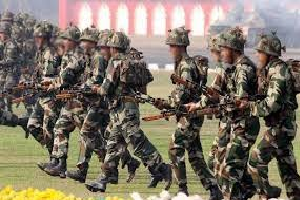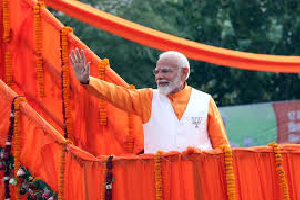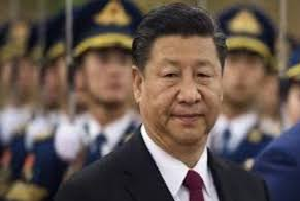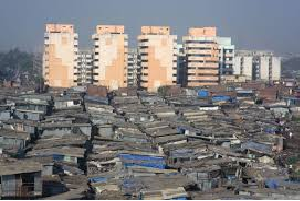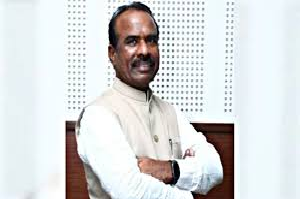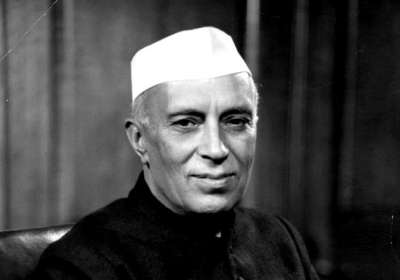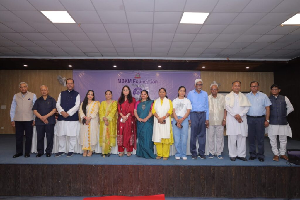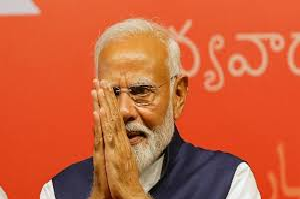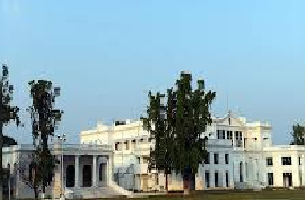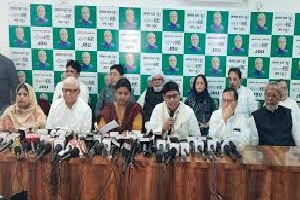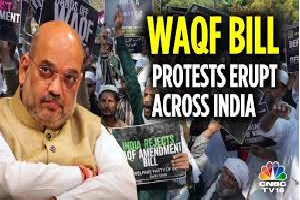2

Today’s Edition
New Delhi, 2 April 2024
Prof. Shivaji Sarkar
The Indian economy requires significant improvement to address the challenges, as highlighted by the International Labour Organization and official indicators, which reveal a deteriorating situation concerning jobs and official stats of a 31 per cent decline in foreign direct investments (FDI).
The ambitious government projections of a $ 3 to 5 trillion economy and other figures are not in sync. A rise in the stock market is not supported by strong indicators else FDI cannot fall so drastically at a critical political juncture.
The country is receiving short-term fly-by-night foreign portfolio investments at stock markets. The FDI indicates the investor's confidence in the system. It is promised but is not flowing in. There are UNCTAD studies that show interest in India but the actual flow has usually been weak. India’s inequality is attracting the attention of world powers.
The Indian economy is currently facing significant challenges, as highlighted by the International Labour Organization (ILO) and official indicators, which show a deteriorating situation concerning jobs and a 31 per cent decline in foreign direct investments (FDI). The government's ambitious projections of a $3 to $5 trillion economy are not in sync with the current economic reality. Despite the rise in the stock market, FDI has been weak, with the country receiving short-term foreign portfolio investments instead.
India's inequality is also attracting the attention of world powers, with the Inequality Report 2022 finding that a monthly salary of Rs 25,000 puts a person among the top wages earned. The report emphasizes the broken link between education and employment, with a large proportion of highly educated young men and women being overqualified for their jobs.
The employment challenge cannot be left to the markets alone, with production in manufacturing becoming capital-intensive and high manufacturing growth necessary for employment generation. The government's investment in construction and real estate is not a sufficient solution.
India's youth employment profile suggests that the country is passing through a difficult phase, with the share of youth who are not in employment, education, or training averaging 29.2 per cent between 2010 and 2019. The ILO report calls for promoting job creation, improving employment quality, addressing labour market inequalities, strengthening skills and active labour market policies, and bridging the knowledge deficits on labour market patterns and youth employment.
A State Bank of India study on women's collectives has brought out the gains that aspiring lakhpati did, but there is still a distance to cover on income, employment, and human capital. Women are often not preferred for jobs that entail maternity and childcare benefits, with about 53.3 per cent of the female workforce being self-employed in 2019.
The nation needs to ponder why it should dip into high debts, with annual repayments of over Rs 10 lakh crore, squeezing the actual budgetary allocation. A policy review is called for the entire financial system, manufacturing, employment, and New Education Policy.
The Inequality Report 2022 brought out by the Institute of Competitiveness based on Periodic Labour Force Survey (PLFS) 2019-20 finds that a monthly salary of Rs 25,000 puts a person among the top wages earned. It is interpreted as a challenge to securing development with dignity for all and actual growth.
The ILO report is vocal about the employment challenge that cannot be left to the markets alone. Production in manufacturing is becoming capital-intensive. Without high manufacturing growth, employment generation might continue to disappoint. Is it for that reason the government investing in construction and real estate? It is internationally accepted that about two-thirds of infra investments are frittered away in various kinds of cuts. Be it Southeast Asia or any other region, infra investments have resulted in severe meltdowns.
India’s youth employment profile suggests country passing through a difficult phase. The share of youth who are not in employment, education or training has averaged 29.2 per cent between 2010 and 2019, the highest in the subcontinent. There is a high proportion of unemployed educated youth even as industry complains of a shortage of skilled jobs.
The report emphasises the broken link between education and employment. “A large proportion of highly educated young men and women, including the technically educated, are overqualified for the job they have”. It is a reflection on the education system and the New Education Policy (NEP) that stresses an extended four-year-undergraduate degree course and high qualifications for a PhD. This is a common phenomenon across the country as youth with such unusually high qualifications pine for blue-collar public sector jobs in the hope of job security. About 3700 PhDs applied for the post of a peon in UP police where class 5 was the eligibility criterion,
It's an unsavoury comment on the education system and the private sector, which has thrown even the basic labour laws to the wind. The ILO report stresses 1) promoting job creation; 2) improving employment quality; 3) addressing labour market inequalities; 4) strengthening skills and active labour market policies; and 5) bridging the knowledge deficits on labour market patterns and youth employment. The NEP does not answer these queries.
It flags the challenges of addressing inequalities, improving the quality of jobs and fixing asymmetries in the labour market. A State Bank of India study on women’s collectives brings out the gains that aspiring lakhpati did. However, on income, employment and human capital there is still a distance to cover.
The ILO report calls for giving primacy to labour-intensive manufacturing employment to absorb unskilled labour. A comparison with China’s shortfall in infrastructure funding promises to SE Asia on the Belt and Road Initiative (BRI) may be a lesson for India, as per a study by Syndey’s Lowy Institute. It is a pointer to the huge gap in funding and long gestation period. Only 35 per cent of infra projects are seen through completion. The funding is falling through by $ 50 billion. The Lowy report is a caution for India for desisting from investing in infra projects. Poor quality of construction of bridges and other infra, including too many roads in Maharashtra, Gujarat of Bihar are testimonies to the failures.
Women are often not preferred for jobs as these entail maternity and childcare benefits. About 53.3 per cent of the female workforce was self-employed in 2019. It rose to 62 per cent in 2022. Many of them are employed but paid low or no wages.
The weak consumption data in the GDP numbers indicate that over the past decade, inflation-adjusted earnings of regular salaried and self-employed persons declined. Possibly, it is the post-demonetisation syndrome that devastated the small and medium entrepreneurs.
An issue that the reports have not discussed is the marginalisation of public sector companies and gradual disinvestment. A fallout is testified by the electoral bond donations. The Rs 12000 plus crore donations are grim pointers that the private sector functions on the principles of giving donations and in return getting back expensive projects.
These are dependent on the government doles at the cost of PSUs. A real private sector has not yet emerged in this country. This has been the pattern in the licence-permit raj as well and continues in the era of liberalisation. Why should a country foster such an unethical business model? Much of the failings underlined by the ILO or PLFS are grim reminders of poor consumption and a failing business system.
The nation needs to ponder why it should dip into high debts which have annual repayments of over Rs 10 lakh crore exponentially squeezing the actual budgetary allocation to around Rs 37 lakh crore, far away from the $ 3 trillion target. A policy review is called for the entire financial system, manufacturing, employment and New Education Policy.
The country is on an experimentation spree and has yet to stabilise its policies. The high prices are obstructions. Parliament is unnecessarily busy making laws or redrafting the old ones. No wonder the chief economic advisor, the highest think tank, says the government can’t solve the problem of unemployment. Post poll all national and regional parties and institutions must come together to redraft the sustainable growth path and manufacturing policies, including the revival of PSUs for proper quality job creation, a strong ILO suggestion.
Even as the country goes to one of the most interesting elections being held, the economy needs a lot to brighten up to provide a comprehensive solution to the challenges as indicated by the International Labour Organization and the official indicators showing a worsening situation regarding jobs and 31 per cent shrinkage in foreign direct investments (FDI)
CEA govt can't solve the problem of unemployment
infrastructure funding promises to Southeast Asia are falling short by more than $50 billion, according to a new report, with mega projects undertaken under the Belt and Road Initiative (BRI) stagnating or failing due to poor planning, the global clean energy transition, and political lurches in recipient countries.
The report, released today by Sydney’s Lowy Institute, found that China remains “easily” the region’s largest infrastructure funder, involved in 24 out of the region’s 34 infrastructure megaprojects, which are defined as those costing $1 billion or more. At the same time, “there is a significant gap between China’s promises and its implementation, between what Beijing commits to and what it delivers.”
According to the Lowy report, this shortfall totals more than $50 billion, more than half of which is “allocated to projects that have been cancelled, downsized, or otherwise seem unlikely to proceed.” Currently, only 35 per cent of China’s infrastructure projects have been seen through to completion, compared to 64 per cent for Japan and 53 per cent for the Asian Development Bank (ADB).
Of the 24 megaprojects mentioned above, eight worth about $16 billion have been completed, including high-profile railway projects in Indonesia and Laos. Another eight, worth $35 billion, are on track, though two have been “substantially downsized.” Meanwhile, “five projects worth $21 billion have been cancelled, while another three projects worth $5 billion seem unlikely to proceed.”
The report puts this funding gap down to three factors. The first is China’s “almost exclusive focus on financing ambitious megaprojects especially prone to problems and delays.” Impressive megaprojects have always been a hallmark of Beijing’s BRI, but the greater cost and complexity of these projects mean that they are more likely to run into political or financial hurdles.
Or provide a
"Markets may not provide a comprehensive solution to the economic challenges, as indicated by the International Labour Organization (ILO) and the government's official indicators showing a worsening situation regarding jobs and FDI."Markets alone may not be a solution to the myriad economic problems. Jobs are a problem says ILO and government data highlights that foreign direct investments (FDI) shrink by 31 per cent.
despite problems despite Policy decisions need
On its march to a $3 trillion economy (Words 1485)
---------------


